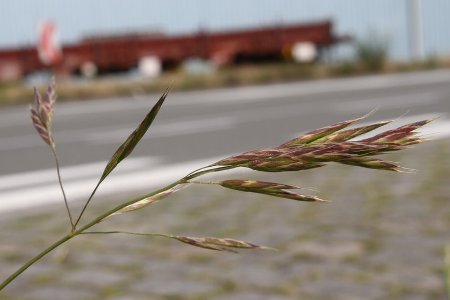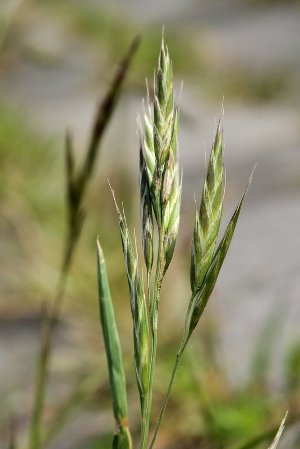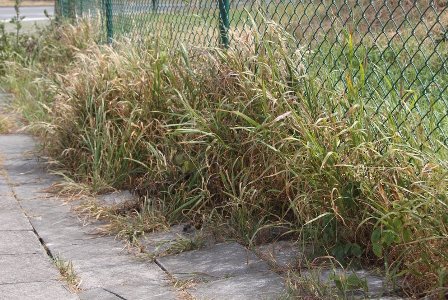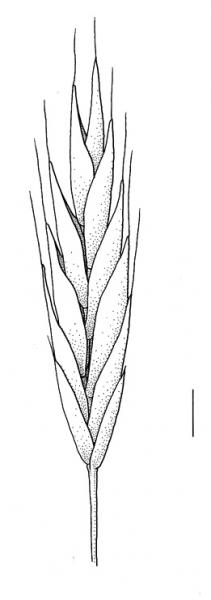Bromus carinatus Hook. et Arnott (syn.: Ceratochloa carinata (Hook. et Arnott) Tutin) (N-Am.) – [THIS ACCOUNT IS NO LONGER UP-TO-DATE, please see Verloove 2012] An increasing, locally naturalised alien. From the 1950’s onwards recorded in Brussel, at first as an escape from the former Botanic Garden. Now very well established and spreading in that area (Saintenoy-Simon & al. 1995, Saintenoy-Simon 1997, Verloove 2002, 2006a, 2012). More recently discovered in several, very widely scattered locations across the country but apparently much more rare in Wallonia. Bromus carinatus usually grows on rough ground, canal banks or roadsides. Also frequently associated with grain importation but perhaps more regularly so in the past. In 2011 also seen as a weed in a maize field in Lichtervelde.
In Belgian herbaria Bromus carinatus has surprisingly often been confused with (awned forms of) B. inermis. The former is a loosely caespitose plant with lower glumes 3-5(-7) veined, whereas the latter is a rhizomatous plant with lower glumes 1(-3) veined. Moreover, palea texture appears to be quite different in both taxa: in Bromus carinatus (and other taxa of section Ceratochloa) the palea exhibits at maturity the same texture as the lemma (with a narrow hyaline margin around the keel), whereas in B. inermis (and related taxa) the palea is almost entirely membranous.
Bromus carinatus is here treated in a broad sense. Most populations (including those from Brussel) have very long-pedicelled spikelets and correspond rather well with Bromus sitchensis Trin. (syn.: Ceratochloa sitchensis (Trin.) Cope et Ryves) (det. R. Portal) but are otherwise poorly distinguished; they are probably mere variants of the former. The length of the lower panicle branches in fact seems to be correlated with age: “typical” plants of Bromus sitchensis often correspond rather with B. carinatus when collected earlier. Moreover, palea- and rachilla length – important characters to distinguish between Bromus carinatus and B. sitchensis according to Portal (1995) – appear to be variable within one specimen, sometimes even within one spikelet. Swedish records of Bromus sitchensis – the oldest binomial of the two –, in fact, include B. carinatus (Ekman 1989). However, if a (micro-) species name should be designated to the Belgian plants than Bromus sitchensis evidently is the name to apply (Verloove 2012).
The populations formerly naturalised near the Botanic Garden in Brussel are characterised by hairy spikelets and/or leaf sheaths and slightly shorter lemma-awns and have been ascribed to another North American taxon, Bromus marginatus Nees ex Steudel (syn.: Ceratochloa marginata (Nees ex Steudel) B.D. Jacks.) (Fasseaux 1948; see also Jansen & Wachter 1918). However, these diacritic features are shared with forms of Bromus carinatus and both are perhaps better considered as conspecific. In North America Bromus marginatus was recently reduced to varietal rank under B. carinatus (Barkworth & al. 2006).
Few collections resemble somehow Bromus stamineus E. Desv. (syn.: Ceratochloa staminea (E. Desv.) Stace), a South American species with narrow leaves and sparsely to densely pubescent lemmas (cf. Stace 2010). With its long-awned lemmas it is usually accommodated in the Bromus carinatus-group but it has recently been given varietal rank under B. catharticus as well (var. elatus (E. Desv.) Planchuello; see Planchuello 2006). As a matter of fact, this taxon is hardly separated and the diacritic features given by Stace l.c. are variable: lemmas can be either glabrous or pubescent (Pavlick & Anderton 2007) and leaves are up to 7 mm wide (Planchuello l.c.). Moreover, after transferring this taxon to Bromus catharticus s.l. the delimitation between this species and B. carinatus is further blurred, especially because palea dimensions of var. elatus correspond with those of B. carinatus (palea subequal to lemma). Massa & al. (2004) probably correctly reduced the number of South American representatives of this species-complex to two.
 |
 |
 |
 |
Selected literature:
Barkworth M.E., Anderton L.K., McGrew J. & Giblin D.E. (2006) Geography and morphology of the Bromus carinatus (Poaceae: Bromeae) complex. Madroño 53: 233-243.
Borkowsky O. & Hartwig U. (1997) Vorkommen und Vergesellschaftung von Bromus carinatus Hooker & Arnott bei Gifhorn - SO-Niedersachsen. Braunschweiger naturkundliche Schriften 5(2): 467-477. [available online at: http://www.ruderal-vegetation.de/epub/bromus_carinatus.pdf]
Brainerd R.E., Otting N. & Wilson B.L. (2016) New combinations in Bromus sitchensis (Poaceae). Phytoneuron 2016-36: 1-4. [available online at: http://www.phytoneuron.net/2016Phytoneuron/36PhytoN-Bromussitchensis.pdf]
Clement E.J. (1981) Sweet bromegrass in Britain. BSBI News 28: 12-14.
Ekman J. (1989) Sloklosta Bromus sitchensis och plattlosta B. willdenowii i Sverige. Svensk Bot. Tidskr. 83: 87-100.
Fasseaux W. (1948) Note sur une graminée introduite nouvelle. Bromus marginatus. Bull. Soc. Roy. Bot. Belg. 80: 76-77.
Floristenclub Gelderse Vallei (1970) Bromus carinatus Hook. et Arn. en Puccinellia distans (L.) Parl. in Midden-Nederland. Gorteria 9: 232-234.
Hohla M. (2012) Bromus sitchensis – neu für Österreich, Plantago coronopus - neu für Oberösterreich sowie weitere Beiträge zur Kenntnis der Flora des Innviertels. Stapfia 97: 180-192.
Jansen P. & Wachter W.H. (1918) Floristische aanteekeningen. XV. Nederl. Kruidk. Arch. 1918: 90-110.
Massa A.N., Jensen K.B., Larson S.R. & Hole D.J. (2004) Morphological variation in Bromus sect. Ceratochloa germplasm of Patagonia. Canad. J. Bot. 82: 136-144.
Mirek Z. (1984) Bromus carinatus Hook. et Arn. A new synanthropic plant species in the flora of Poland. Fragm. Flor. Geobot. 28(2): 97-105.
Pallas J. (1994) Bromus carinatus Hooker & Arnott in Deutschland. Flor. Rundbr. 27(2): 84-89.
Pavlick L.E. & Anderton L.K. (2007) Bromus. In: Barkworth M.E. & al. (eds.), Flora of North America north of Mexico, vol. 24: 193-237. Oxford University Press, New York-Oxford.
Planchuelo A.M. (2006) A new combination in the Bromus catharticus complex (Poaceae: Bromeae sect. Ceratochloa). Sida 22: 555-560.
Portal R. (1995) Bromus de France. Vals près Le Puy: 111 p.
Reynolds S. (1988) Bromus carinatus Hooker and Arnott, a grass new to Ireland. Irish Nat. J. 22(12): 535-536.
Saintenoy-Simon J. (1997) Le Quartier Nord, à Bruxelles, une pépinière d’espèces rares. Adoxa 17: 22-24.
Saintenoy-Simon J., Godefroid S. & Verhelpen B. (1995) Groupe Flore Bruxelloise. Notes floristiques relatives à la Région de Bruxelles-Capitale (1991-1993). Adoxa 6-7: 27-37.
Sigl J. (2008) Die Plattährige Trespe (Bromus carinatus Hooker & Arnott 1840) im Gebiet der Regnitzflora. RegnitzFlora 2: 17-30.
Stace C. (2010) New flora of the British Isles, 3th ed.: XXXII + 1232 p. Cambridge University Press.
Stoddart J.M. (1982) Sweet brome (Bromus carinatus). BSBI News 32: 21.
Verloove F. (2002) Ingeburgerde plantensoorten in Vlaanderen. Mededeling van het Instituut voor Natuurbehoud n° 20: 227 p.
Verloove F. (2006a) Bromus carinatus. In: Van Landuyt W., Hoste I., Vanhecke L., Van den Bremt P., Vercruysse W. & De Beer D., Atlas van de flora van Vlaanderen en het Brussels gewest. Instituut voor Natuur- en Bosonderzoek, Nationale Plantentuin van België en Flo.Wer: 194.
Verloove F. (2012) A revision of Bromus section Ceratochloa (Pooideae, Poaceae) in Belgium. Dumortiera 101: 30-45. [available online at: http://alienplantsbelgium.be/sites/alienplantsbelgium.be/files/Dum%20101...
Weddeling K. & Klingenstein F. (2007) Eingebürgert im Bonner Raum - Bromus carinatus Hook. & Arnott, Polycarpon tetraphyllum (L.) L. und Juncus ensifolius Wikstr. Floristische Rundbriefe 40: 1-6. [available online at: http://www.weddeling.info/weddeling_klingenstein.pdf]

